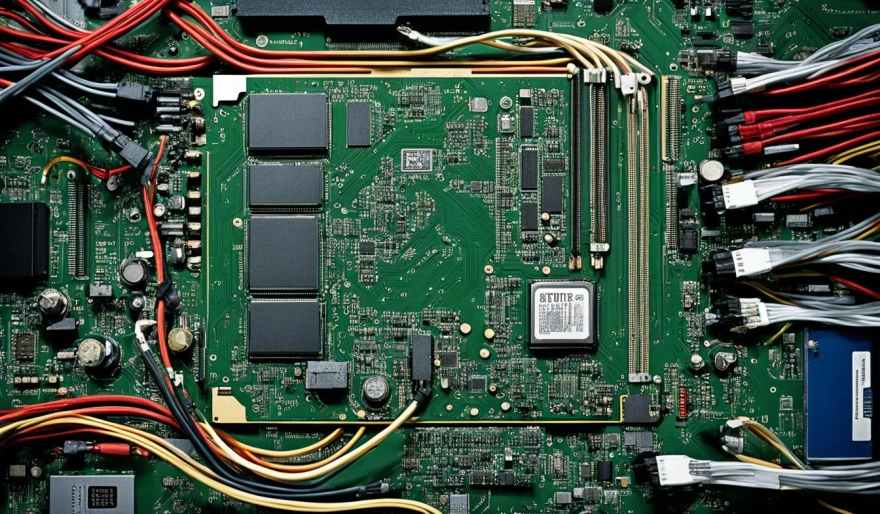ATI Technologies: Gone But Not Forgotten ATI Technologies: Gone But Not Forgotten
29 min read ATI Technologies: Gone But Not Forgotten -written by Amine Rukhi, Content Creator June 27, 2024 08:32
ATI Technologies: Gone But Not Forgotten
ATI Technologies once stood at the forefront of the tech world. Its journey shows how an innovative graphics company can impact the world. For more than 25 years, ATI was a key player in creating the gaming and multimedia we know today.
Although the ATI brand is no longer at the top, its legacy remains strong. Many still remember and cherish ATI's contributions. They inspire today's tech lovers and those who have been part of the industry for years.
Key Takeaways
- ATI Technologies was a Canadian-based graphics company that made significant contributions to the computing and gaming industries.
- The company was founded in 1985 with just $230,000 in loans and investments, showcasing its humble beginnings.
- ATI's early products, like the Graphics Solution card, EGA Wonder, and VGA Wonder, were affordable and showed constant improvement.
- The release of the ATI68800 (Mach32) graphics processor in 1992 boosted VGA control, color depth, and hardware acceleration.
- ATI faced tough competition, which led to financial hardship. But this motivated them to keep innovating and changing.
The Birth of a Graphics Giant
In 1985, Lee Lau, a fresh University of Toronto graduate, teamed up with Benny Lau and Kwok Yen Ho. Together, they started Comway. Their aim was simple: create basic expansion cards and graphic adapters for IBM PCs. The trio worked from Hong Kong, launching their business officially as Array Technology Incorporated (ATI) the following year. ATI's mission was to craft top-tier video acceleration chipsets using gate arrays.
From Humble Beginnings
Born on May 16th, 1956, Lee Lau made his way to Toronto, Canada, as a student longing for more learning opportunities. He immersed himself in electrical engineering, showing a keen interest in electronics and computer technologies. Lau saw these technologies' emerging potential early on, switching from manual calculations to electronic tools during his studies.
Array Technology Incorporated
ATI's founders saw a great chance in the video acceleration field for IBM and its clones. They noticed a gap left by the big CPU and GPU providers, creating an opening for smaller players. Exploring graphics, they believed, would lead to a more profitable venture with better margins.
ATI launched with a focus on gate array-based video accelerator chipsets. This strategy helped them thrive in the graphics market. Their first notable creation was an IBM PC-AT clone. It featured advanced hardware for its time, proving their capability to offer cost-effective and efficient solutions.
| Product | Price | Specifications |
|---|---|---|
| ATI Mach8 Graphics Accelerator | $10,000 cheaper than 8514/A equipped PS/2 | TMS34020 EISA based dGPU, capable of 1080p and 32-bit true color |
| IBM PC-AT Clone | $10,000 in 1986 | 8 MHz 80286 CPU, 1MB RAM, 20MB HDD, EGA graphics |
| Apple ][ Clone | $2,000 in 1983 | Z-80, 80-column card, dual 140k floppy drives, monochrome monitor |
Starting small, ATI Technologies grew into a key player in the graphic industry, leading with innovation. They shaped how we view computer graphics today.
Rise of the Wonder Cards
ATI Technologies became a key player in the graphics card world by the end of the 1980s. After less than a year, they launched the Graphics Solution, which cost $300. It was compatible with any open 8-bit ISA slot and could show various graphics. This step marked the start of ATI's successful journey.
Graphics Solution and EGA Wonder
ATI didn't stop with the Graphics Solution. They released the EGA Wonder in 1987, priced at $400. The EGA Wonder outperformed its precursor, meeting the market's desire for better graphics. It quickly became popular, boosting ATI's standing in the industry.
VGA Wonder and Product Lineup
The company grew its offerings in 1988 with the VGA Wonder at $500. This VGA Wonder was a big step forward in graphics, handling many resolutions and colors. ATI kept up by introducing updated versions of their cards to match changing market needs and prices.
ATI embraced innovation and focused on making what customers wanted through its "Wonder" series. This commitment made the "Wonder" cards symbols of quality and stability. They showed off ATI's know-how and built its image as a leader in powerful graphic solutions.
"The EGA Wonder and VGA Wonder were game-changers in the graphics card market, offering exceptional performance and value to consumers."
ATI's dedication to creating better graphics paved the way for its success in the 1990s. As the tech world changed, ATI's forward-thinking, customer-focused approach guided the graphics card market's direction.
Mach Enters the Stage
In the 1980s, the computer world was changing fast. It needed to turn info into signals for monitors. This led to a great opportunity for a special co-processor. IBM saw this need and brought out its 8514 display adapter in 1987. This move inspired others, like ATI Technologies, to make their own versions.
IBM's 8514 and ATI38800 Chip
When IBM released the 8514, ATI responded with the ATI38800, also called the Mach8. It had a special processor for 2D graphics jobs. This made the main CPU do less work, which sped up the whole system. The Mach8 was a big deal for ATI. It showed they could compete in making special graphics processors. ATI's success with the Mach8 laid the foundation for their work in future 2D and 3D graphics.
"The Mach8 chip, a significant milestone for ATI, marked the company's entry into the arena of dedicated graphics co-processors, setting the stage for its future advancements in 2D and 3D graphics acceleration."
| Feature | IBM 8514 | ATI38800 (Mach8) |
|---|---|---|
| Chip Type | Display Adapter | Graphics Co-Processor |
| Functionality | Conversion of Display Information to Monitor Signals | Handling of Certain 2D Graphics Operations |
| Purpose | Improve Display Quality | Offload CPU, Enhance System Performance |
Mach32 and Industry Competition
In the late 1992, ATI Technologies brought out the ATI68800, named the Mach32. It was a cutting-edge graphics processor. The chip had a built-in VGA controller, a 64-bit inside, and could show up to 24-bit colors. This launch was a big step for the company.
The new product, Graphics Ultra Pro, was very strong. Nevertheless, ATI met tough competition from other companies. This led to the company's first big loss, nearly $2 million in 1992.
ATI68800 and Ultra Pro Lineup
The Mach32 marked a big leap for ATI’s graphics technology. It had an integrated VGA controller and strong 64-bit processing inside. With up to 24-bit colors, it offered a better graphics solution. The Graphics Ultra Pro, using the Mach32 chip, was a top product in the market.
Fierce Competition and Setbacks
ATI faced strong competition from others despite its tech advancements. Holding a lead wasn’t easy. This tough rivalry led to a major loss of almost $2 million in 1992.
| Metric | Value |
|---|---|
| AMD's market share in discrete GPUs | Increased from approximately 33% at the end of 2007 to 51% in the last quarter |
| AMD's chipset business recognition | Strongest it has ever been post-acquisition of ATI |
| ATI-AMD merger impact | AMD brand preference triples when survey respondents are aware of the merger |
| AMD's Radeon and FirePro brands | Gained high recognition even without the ATI attachment |
| Perception of AMD vs. ATI brand | AMD brand is generally perceived as stronger than ATI in comparison to graphics competitors like NVIDIA |
| Upcoming Radeon hardware update | Likely to be released under the AMD Radeon HD 6000 series brand |
| AMD's Vision platform brand | Categorized into Vision, Vision Premium, Vision Ultimate, and Vision Black for systems with all AMD components (CPU, chipset, and GPU) |
| OEMs' request for AMD | Provide logos without the AMD brand for systems where Intel CPUs and AMD GPUs are used to avoid confusion |
| ATI employee relocation | Relocated to AMD's base of operations in Austin, Texas, enhancing collaboration on future AMD/ATI products |
| AMD brand simplification at retail | Replace CPU brands like Phenom II, Athlon II, Turion, and Sempron with the Vision badge for AMD-powered desktops/notebooks starting next year |
The table summarizes vital data on ATI Technologies, Mach32, ATI68800, Graphics Ultra Pro, industry competition, and setbacks. It highlights the company's status, brand, and post-merger strategies.
"The acquisition of ATI for $5.4 billion led to the eventual retirement of the ATI brand with the realization that the AMD brand preference triples when the survey respondents are aware of the ATI-AMD merger."
This quote points out the big effect of the ATI-AMD merger on brand views. It shows a shift towards preferring the AMD brand over ATI after the merger.
Rage for 3D Acceleration
In April 1996, ATI Technologies made a big move with the Mach64 GT, known as 3D Rage. It was their first processor to handle 2D and 3D graphics. For example, the 3D Xpression cards with the 3D Rage chip had cool features like Gouraud shading and bilinear texture filtering.
But, the 3D Rage chip wasn't as strong in 3D as some new rivals like 3dfx Voodoo Graphics. People who wanted powerful 3D graphics looked elsewhere. This meant the 3D Rage didn't stand out against its better-equipped rivals.
Mach64 GT and 3D Xpression
The Mach64 GT and 3D Xpression cards were ATI's answer to the fast-changing 3D graphics world. The Mach64 GT aimed to find a good balance between 2D and 3D, appealing to more users.
Even though the 3D Rage chip had its 3D features, it was still behind competitors like 3dfx. This pushed ATI to keep improving their 3D technology. It laid the pathway for their later successes in 3D graphics.
"The 3D Rage chip offered some 3D capabilities, but its overall performance still lagged behind the impressive advancements made by competitors like 3dfx."
As graphics tech advanced, ATI's Mach64 GT and 3D Xpression drew attention. They aimed to meet both 2D and 3D needs. Though not as famous as some rivals, these products set the stage for ATI's success in 3D tech.
ATI Technologies: Gone But Not Forgotten
ATI Technologies faced many struggles but it greatly influenced the gaming industry and tech industry. They led in making graphics faster, introduced unique products, and kept investing in new ideas. This made them key players in making computer graphics better.
In August 1985, ATI started with around $230,000 from bank loans and investments. Their first product, the Graphics Solution, cost $300 and could show different graphics modes. They kept improving, with the EGA Wonder in 1987 and the VGA Wonder in 1988. These newer products were better but also more expensive, at $400 and $500.
ATI faced stiff competition in the industry. For example, their Graphics Ultra Pro, which cost $800 and had 2 MB of VRAM, was up against Cirrus Logic's more affordable options. Cirrus Logic had chips that combined different functions into one, making them cheaper. Yet, ATI innovated by introducing the Mach64 chip family, including products like Xpression, WinTurbo, Pro Turbo, and Charger.
ATI's focus on innovation paid off. They even bought a skilled graphics team in Boston from Kubota Corporation. This key move kept ATI at the forefront, enabling them to offer the best graphics solutions.
Despite losses and market battles, ATI was a major player in the gaming industry and tech industry. Their influence still lives on, especially through successes like the Radeon HD 4800 series and the Radeon 9700 Pro. These products show how ATI pushed the limits of what computer graphics could do.
"ATI Technologies' impact on the gaming and technology industries is undeniable. Their innovative products and unwavering dedication to graphics acceleration have left an indelible mark on the evolution of computer graphics."
| Metric | Value |
|---|---|
| Percentage of owned GPUs that were ATI/AMD cards | 100% |
| Number of ATI/AMD cards owned | 7 cards |
| Number of GPUs purchased for personal use | 8 GPUs |
| Outcome of ATI Radeon 290X crossfire setup | Failure due to one card dying |
| Occurrence rate of ATI Radeon 290X crossfire setup failure | 1 out of 2 cards |
| Temperature of current EVGA 1080Ti FTW3 Hybrid graphics card | Runs at 45°C under factory AIO |
| Impact of GPU mining on the market | Doubled prices of GPUs across North America as the mining boom intensified |
Although ATI Technologies isn't on its own anymore, its impact lingers in the gaming industry and the tech industry. Their unique graphics processing ideas and the dedication to evolve computer graphics have not been forgotten. Their mark on the business is significant.
Multimedia and TV Encoding Advancements
ATI Technologies focused a lot on PC graphics but also led in multimedia and TV encoding. They created the ImpacTV, a special TV encoding chip. This showed ATI could do more than just graphics cards. It proved their strength in improving how computers handle multimedia.
The ImpacTV chip was not their only venture. To boost their multimedia range, ATI added MPEG-2 acceleration to the 3D Rage. This made handling video smoother. It met the rising need for better multimedia on personal computers.
ImpacTV and MPEG Acceleration
ATI's ImpacTV chip was all about TV encoding, letting users record and encode videos on their PCs. This made it easy to use TV tuner cards and other video sources. Users could enjoy a richer multimedia experience.
The 3D Rage didn't fall behind. It also had skills to process MPEG-2 videos well. This meant the graphics chip could help with video work. It lightened the load on the computer's processor, making multimedia smoother.
ATI regularly showed it wanted to do more. By adding special encoding and speeding up MPEG-2, they became a key player in multimedia. This was along with their main work in graphics. They proved to be adapt in the expanding multimedia field.
| Feature | Description |
|---|---|
| Microsoft Windows Media Encoder 9 | Mentioned as an available tool for encoding video content. |
| Lossless CD ripping | Recognized as a feature in media players. |
| Codec source code cost | Referenced a $10,000 cost for related source code. |
| Decoder implementation | Emphasized the cost and expenses involved in making decoders suitable for running on various processors, with a focus on memory usage. |
| Linux decoder support | Mentioned that Microsoft did not plan to release a Linux decoder, indicating a decision against supporting Linux platforms in this context. |
ATI's work in multimedia and TV encoding matched the rise of new digital forms of storytelling. Games like Minecraft and platforms such as VR Chat became places for making stories together. The same happened with Homestuck comic. It let fans take part and shape what happened next.
These new storytelling ways proved multimedia and interactive tech's huge potential. ATI improved TV and video handling to support this change. Their efforts laid the groundwork for the engaging multimedia world we enjoy today.
ATI also looked at new video codecs beyond H.264, like VC-1. Their work with VC-1 showed promise in quality. But H.264, mainly because it was open, became more popular. This was despite VC-1's potential enhancements.
Even with these steps, ATI faced some issues. Making multimedia work well across all devices was tough. They worked to iron out how video is processed effectively. They saw the challenges of providing smooth multimedia in the quickly changing digital scene.
The Radeon Era Begins
After facing issues with the 3D Rage, ATI Technologies kept pushing forward. They entered the Radeon era, a big step for them. The Radeon graphics cards quickly became leaders in the 3D gaming world. This move highlighted ATI as a top name in graphics innovation.
ATI's Transition to 3D Gaming
The Radeon series changed everything. It became very popular among PC gamers. These cards were packed with special features that made games look amazing.
Radeon brought in a new way to process graphics called tile-based deferred rendering. This new method allowed for better performance and picture quality in high resolutions.
Radeon also introduced special features like "Free Trilinear Filtering" and support for Application/Game Profiles. These made graphics better without hurting performance. ATI showed it was all about giving gamers the best experience.
The move to the Radeon era made ATI Technologies a top player in 3D gaming. The Radeon lineup won over PC fans everywhere. It proved ATI was at the forefront of graphics innovation in the years ahead.
Acquisition by AMD
In 2006, AMD made a smart move by acquiring ATI Technologies. This deal, worth $5.4 billion, made AMD a key player in the graphics industry. AMD combined its resources with ATI's technology, now being a strong force in the graphics field.
This merger let AMD and ATI work together, enhancing their impact. They built on ATI's history of new ideas. This was a big step for AMD to compete better in the graphics market against other leaders.
AMD's Graphics Powerhouse
The decision to merge with ATI Technologies greatly benefited AMD. By the last quarter, AMD had grown to have 51% of the discrete GPUs market. This shows they are gaining ground in graphics. Also, people prefer AMD’s brand more when they know about the ATI merger.
The Radeon and Fire Pro names were already strong and stayed that way after the merger. AMD’s Vision platform, with four categories, helped too. It enhanced AMD's position in the graphics world.
Lately, AMD has decided to phase out the ATI brand at stores. They are doing this to simplify and strengthen AMD's brand as a graphics leader.
AMD has also moved key ATI workers to its main base in Austin, Texas. This move aims to keep ATI's valuable knowledge helping in creating new products and ideas within AMD.
| Statistic | Value |
|---|---|
| Acquisition by AMD of ATI | $5.4 billion announced four years ago |
| AMD's discrete GPUs market share | Increased from ~33% at the end of 2007 to 51% last quarter |
| AMD brand preference | Triples when individuals are aware of the ATI-AMD merger |
| Radeon and Fire Pro brands | Have strong brand recognition without the ATI attachment |
| AMD's Vision platform | Introduced with four categories: Vision, Vision Premium, Vision Ultimate, and Vision Black |
| ATI brand retirement | AMD to retire the ATI brand starting late this year |
| ATI employee relocation | AMD is relocating important ATI employees to its base in Austin, Texas |
The deal with ATI Technologies has raised AMD's status in the graphics world. It combined ATI's strengths with AMD’s, making a powerful team. Now, they are set to rival other top companies and keep bringing new tech to the field.
"The acquisition of ATI by AMD was a game-changer in the graphics industry, allowing the combined entity to become a true powerhouse and challenge the established players."
Tech mergers are often difficult, with high chances of not working out. But the way AMD and ATI have joined shows AMD's strong planning and action.
AMD is working hard to stay at the top in graphics. The heritage of ATI plays a big role in this effort. It keeps helping AMD grow and stay innovative in the competitive graphics market.
Conclusion
The story of ATI Technologies shows how important early graphics companies are. Despite tough times, ATI's work keeps affecting computer graphics. This means their pioneering work and new technology won't be forgotten.
As time passed, big companies like AMD and Nvidia took over. Yet, ATI's early efforts are still noticed. It started small but grew big, making key changes in the gaming industry and the tech industry.
Even if people don't talk about it now, ATI's influence is strong in today's computer graphics. The ATI Technologies' story reminds us that real push and first steps can really change things. Even problems can't hide the huge role of true innovation and courage.,
FAQ
When was ATI Technologies founded?
ATI Technologies started in 1985. It was founded by Lee Lau, Benny Lau, and Kwok Yen Ho.
What were ATI's first products?
Their first items were the Graphics Solution and EGA Wonder. VGA Wonder cards followed. These debuted in the late 1980s.
How did ATI's graphics processors evolve over time?
ATI grew from the Mach8 to the Mach64 GT (3D Rage) processors. These showed big leaps in 2D and 3D graphics.
What were some of the challenges ATI faced in the industry?
Their rivals pushed them hard. In 1992, they even lost money. The 3D Rage processor found it tough against newer rivals.
Did ATI diversify beyond graphics cards?
Indeed, they made a TV encoding chip, ImpacTV. Plus, they improved their 3D Rage chip with MPEG-2 tech. This showed ATI was good with multimedia too.
What was the impact of ATI's Radeon line of graphics cards?
ATI's Radeon cards were huge for 3D gaming. They really marked ATI as a leading graphics company.
What happened to ATI Technologies?
AMD bought ATI in 2006. This made AMD stronger in graphics. The merger made a strong graphics team with AMD's resources and ATI's skills.
User Comments (0)
Popular Apps










Editor's Choice









